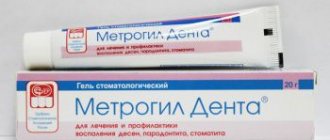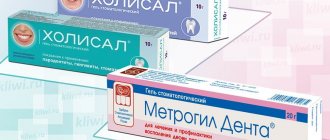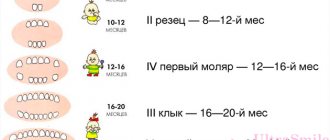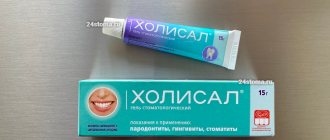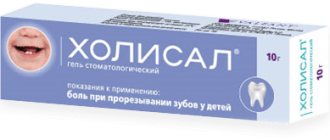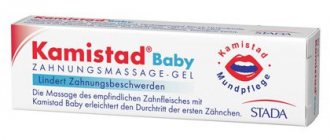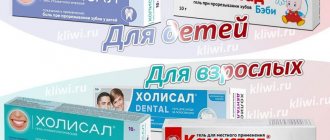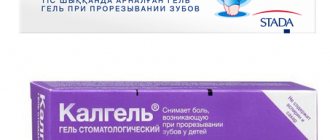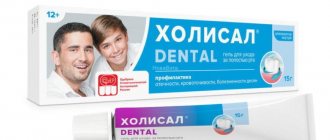Pharmacology and pharmacodynamics
The gel helps fight inflammation, relieves pain and has an antimicrobial effect.
The active substance perfectly anesthetizes the area to which the gel was applied and eliminates inflammation. The analgesic effect lasts for 3-8 hours. Another active component has an antiseptic effect, killing harmful microorganisms.
The medicine has a certain structure, due to which it penetrates well into the tissue and remains on the oral mucosa for several hours. Almost does not enter the blood circulation.
Cholisal: composition, release form
Cholisal is a modern dental drug with a pronounced analgesic, anti-inflammatory and antibacterial effect. The gel acquires its unique healing properties thanks to a combination of the following active ingredients:
- Anise oil (1.6 mg per 1 g of gel) is a natural oil that has a calming effect on inflammation and kills pathogenic microorganisms;
- cetalkonium chloride (87.1 mg per 1 g of gel) – a broad-spectrum antiseptic;
- Choline salicylate (100 mcg per 1 g of gel) is an analgesic that also relieves inflammation.
Auxiliary components: 50 mg of glycerin, up to 1 g of water, 390 mg of ethyl alcohol, 20 mg of hyaetellose, 1.5 mg of methyloxybenzoate, 0.8 mg of propyl parahydroxybenzoate.
Why is this composition so good?
When most dental preparations that are used topically differ only in their superficial effect, Cholisal gel penetrates into the deep layers of the oral mucosa. This property is given to the gel by the active substance choline salicylate. The component formed from salicylic acid acts on the site of inflammation, blocking inflammatory mediators in the oral mucosa. The analgesic component has a light structure, so it penetrates quite deeply into the layers of the mucous membrane.
Cholisal gel acts simultaneously on bacteria, fungi and viruses; this universal property is given to it by a broad-spectrum antiseptic - cetalkonium chloride.
The product is available in gel form, 10 g in aluminum tubes, sealed cardboard packs.
When to use
The gel is prescribed in the following cases:
- stomatitis;
- cheilitis;
- damage to the integrity of the mucosa due to the use of prostheses or as a result of mechanical impact;
- pain relief after dental surgery;
- when teething in babies;
- other damage and inflammatory processes in the oral mucosa.
Purpose of Cholisal gel
Dentists recommend using Cholisal for the following diseases:
- stomatitis of any etiology;
- periodontitis;
- gingivitis;
- cheilitis (inflammation of the lips);
- oral candidiasis (thrush of the oral mucosa);
- lichen planus in the oral cavity;
- inflammation in the hoods above the wisdom teeth.
Cholisal is also recommended for use in the following cases:
- for damage to the oral cavity: from dentures, injuries, after surgical intervention;
- for pain relief during teething.
Adverse reactions and overdose
In rare cases, side effects may occur. A tingling or burning sensation may be felt at the sites where the ointment is applied. This reaction usually disappears after a few minutes. Various allergies may also appear.
No cases of overdose have been identified to date. The gel does not need to be swallowed, only used topically. If there is a lot of ointment on the mucous membrane, then you need to rinse your mouth well. If the composition gets into the gastrointestinal tract, you need to rinse the stomach. Treatment is carried out taking into account the existing symptoms.
Holisal: reviews from specialists and patients
What can you say about Holisal?
Only good. All specialists from the dental industry speak only positively about the drug. Negative reviews are extremely rare, and, as a rule, they are from patients who made mistakes in trying to self-medicate. For example, some patients begin to use the product without first consulting a dentist, completely forgetting that inflammation in the mouth always has a cause. In such cases, using Cholisal alone is not enough, since the treatment will be ineffective and short-term. Therefore, it is necessary to discover the cause and carry out full therapy to avoid relapse of the disease.
What benefits do doctors and patients notice?
- Versatility of use. Cholisal is available in one form, which allows it to be used by both adults and children. There are no age restrictions, the gel is safe and effective for everyone.
- In normal doses, the drug is inert and does not react with other drugs, which makes it possible to include it in combination therapy.
- No risk of overdose.
- No sugar in the composition.
- The drug penetrates deeply into tissues, providing a stronger and longer-lasting therapeutic effect.
- Quickly relieves pain.
- Cholisal gel does not affect the psychomotor state of the patient, so it can be used while driving a vehicle or when working with complex mechanisms.
- The gel is applied topically, which eliminates a number of side effects that can usually occur with oral medications.
- Availability and popularity. Cholisal is sold without a prescription, so you can easily purchase it at any pharmacy.
Reviews
Regarding the use of the gel during teething, you can find mostly positive reviews. The drug quickly and effectively copes with inflammatory processes, relieves pain and cools the affected area. If you use the product the night before going to bed, its effect will last almost until the morning. It also has an antipyretic effect. For many, it is a plus that the composition does not contain lidocaine, since it can provoke various and severe allergies.
There are also many positive reviews when using ointment for stomatitis. Within 3-5 minutes you can notice a significant improvement in your condition, pain and discomfort disappear. Inflammation disappears 15-20 minutes after application. If you apply compresses before going to bed, you can quickly get rid of the problem and its symptoms.
special instructions
Despite the many advantages and high safety of the drug, dentists all recommend adhering to several rules:
- Gel in large doses can enhance the effect of antipyretics, analgesics and anti-inflammatory drugs, so it is especially important to monitor the dose of the gel used if you take such drugs.
- Women during lactation and pregnancy, as well as children under 1 year of age, are advised to use the gel with caution.
Basic treatment methods
Correct and complete treatment for periodontal inflammation is prescribed directly by a periodontist. The treatment complexes at the initial stage of treatment include such manipulations as removing dental plaque and excess fillings, sharpening sharp tooth edges and eliminating bite defects.
To rid the oral cavity of dental deposits, dentists carry out professional cleaning using a chemical method (using acids, alkaline preparations), sonic (influencing deposits with ultrasound or sandblasting), or mechanical methods (using special periodontal hooks, probes, excavators). In addition to removing tartar, the oral cavity is simultaneously treated with one of the antiseptic solutions (hydrogen peroxide 3%, chlorhexidine bigluconate). Next, the doctor should help the patient choose basic hygiene products (toothpaste and brush, suitable hardness), mouth rinse and dental floss. As a rule, preference is given to products that have antibacterial properties and also contain herbal complexes.
If there are inflammations with purulent contents in the mouth, in this case it is appropriate to use medications containing antibiotics (most often presented in the form of gels and powders).
It is worth remembering about additional physical treatment methods, such as gum massage, leech treatment and physiotherapeutic procedures. For example, darsonvalization for periodontal disease normalizes metabolism and stops the atrophy of gingival tissue, the use of electrophoresis with calcium gluconate reduces sensitivity in the area of exposed tooth necks, and massage helps accelerate blood flow to the gums, which improves their metabolic processes.
Gel Cholisal: analogues and prices
Gel Cholisal - the price for March 2022 is about 370 rubles.
The Polish drug has a direct analogue - “Mundiesel gel”, but its cost is higher, and the contents of the tube are only 8 grams.
The following drugs have a similar therapeutic effect:
- Kamistad.
- Dental.
- Dentamet.
- Deoxynate.
- Periodonticide.
- Metrogil Denta.
- Anti-Angin.
- Faringosept and others.
Comparison with other drugs
As we can see, the choice of drugs for the treatment of the oral mucosa is considerable, but all these drugs have mainly a superficial and narrow therapeutic effect. For example, today there is a large selection of dental drugs that have only an antibacterial effect. Such products most often include antibiotics and antiseptic components (chlorhexidine, metronidazole). Such drugs include Asepta-balsam, Metrogyl Denta, Faringosept and others.
There are also dental products on the market that have only an anti-inflammatory effect (for example, “Parodontocide”) or an analgesic effect (for example, “Kamistad”, “Dentol”).
Therefore, we can say that the composition of Cholisal is unique in its kind. It simultaneously has anti-inflammatory, antibacterial, antimycotic and analgesic effects, which most other dental products cannot boast of.
Causes of periodontal disease
Most often, there are several reasons for the appearance of the disease, one of which is a violation of metabolic processes in the patient’s body. In addition, there are a number of reasons that usually go in parallel with periodontal disease:
- diseases of the gastrointestinal tract;
- hormonal imbalance, disruption of the endocrine system;
- bite pathology;
- the presence of bad habits such as smoking cigarettes and excessive alcohol consumption;
- decreased immunity;
- lack of vitamins and nutrients;
- atherosclerosis, high blood pressure;
- a history of diabetes mellitus;
- hereditary factor;
- the presence of plaque of natural origin.
Symptoms of periodontal disease
According to statistics, patients do not know about the onset of the disease, since at first it goes unnoticed. But during a dental examination, patients complain of:
- painful reaction to hot, cold, sour;
- constant bleeding gums, bloody taste throughout the day;
- swelling and soreness of the gums;
- a putrid odor from the mouth is noticed immediately after brushing;
- emerging tooth mobility.
Cholisal: instructions for use
The gel is easy to use. According to the original instructions, Cholisal should be used as follows:
- Adults apply a strip of the product up to 1 cm (children up to 0.5 cm) onto their finger, then distribute the gel over the surface of the affected area of the oral mucosa, rub the product in with light and massaging movements. The procedure must be carried out 2-3 times a day, but only after meals and before bed.
As you can see, the instructions tell you only the most important things about the application, but the method of using the gel in different clinical situations is completely different. Let's take a closer look.
The use of Cholisal for gum inflammation.
Gingivitis and periodontitis
– serious dental diseases that require complex therapy. Treatment should begin with removing deposits on the teeth, then you need to take courses of rinsing with antiseptics, include Cholisal in therapy and replace regular toothpastes with anti-inflammatory ones.
If you start using dental gel immediately, without affecting the cause of inflammation, then the effect of such therapy will be unjustified. Moreover, starting treatment with the gel can only worsen the situation, turning the disease into a chronic form.
Typically, gel therapy for gum inflammation lasts no more than 10 days. The product is applied twice a day - in the morning and evening, always after meals, rinsing with antiseptics and drying the gums with a gauze swab. After the procedure, you are not allowed to eat for the next 2 hours or drink for 30 minutes.
Cholisal, use for stomatitis
For herpetic stomatitis, Cholisal is used exclusively for pain relief from erosions. In case of aphthous stomatitis, there is no point in using the gel, since the disease occurs due to allergies.
Using gel during teething
Adults, children and teenagers can relieve teething discomfort with Cholisal. It is not recommended to use the gel to relieve gum pain in infants, since anise oil stimulates excessive salivation, which can lead to irritation and choking.
The affected area must be treated with the product, after drying the mucous membrane with a gauze swab. The procedure can be repeated about 3-4 times a day. This medicine is used only in the absence of swelling of the cheeks, suppuration and other serious complications.
